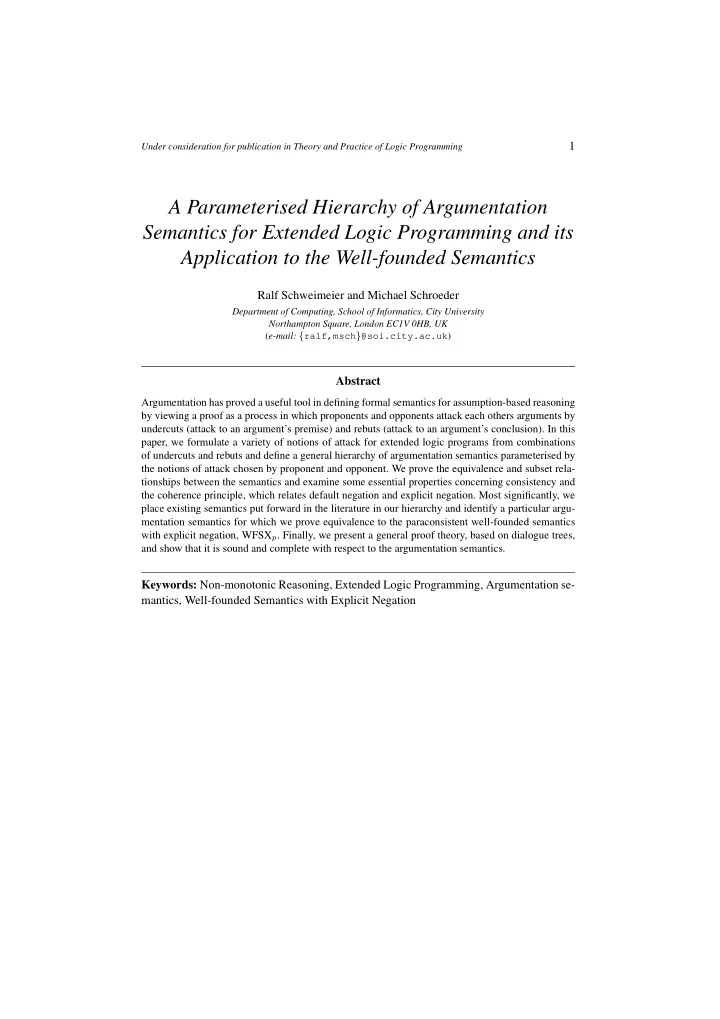

1 Under consideration for publication in Theory and Practice of Logic Programming A Parameterised Hierarchy of Argumentation Semantics for Extended Logic Programming and its Application to the Well-founded Semantics Ralf Schweimeier and Michael Schroeder Department of Computing, School of Informatics, City University Northampton Square, London EC1V 0HB, UK ( e-mail: { ralf,msch } @soi.city.ac.uk ) Abstract Argumentation has proved a useful tool in defining formal semantics for assumption-based reasoning by viewing a proof as a process in which proponents and opponents attack each others arguments by undercuts (attack to an argument’s premise) and rebuts (attack to an argument’s conclusion). In this paper, we formulate a variety of notions of attack for extended logic programs from combinations of undercuts and rebuts and define a general hierarchy of argumentation semantics parameterised by the notions of attack chosen by proponent and opponent. We prove the equivalence and subset rela- tionships between the semantics and examine some essential properties concerning consistency and the coherence principle, which relates default negation and explicit negation. Most significantly, we place existing semantics put forward in the literature in our hierarchy and identify a particular argu- mentation semantics for which we prove equivalence to the paraconsistent well-founded semantics with explicit negation, WFSX p . Finally, we present a general proof theory, based on dialogue trees, and show that it is sound and complete with respect to the argumentation semantics. Keywords: Non-monotonic Reasoning, Extended Logic Programming, Argumentation se- mantics, Well-founded Semantics with Explicit Negation
2 Ralf Schweimeier and Michael Schroeder Contents 1 Introduction 3 2 Extended Logic Programming and Argumentation 4 2.1 Arguments 5 2.2 Notions of attack 7 2.3 Acceptability and justified arguments 10 3 Relationships between Notions of Justifiability 12 3.1 Equivalence of argumentation semantics 12 3.2 Distinguishing argumentation semantics 14 3.3 A hierarchy of argumentation semantics 16 4 Properties of Argumentation Semantics 18 4.1 The coherence principle 18 4.2 Consistency 19 5 Argumentation Semantics and WFSX 20 5.1 Well-founded semantics with explicit negation 21 5.2 Equivalence of argumentation semantics and WFSX p 21 6 Proof Theory 25 6.1 Dialogue trees 25 7 Related Work 27 8 Conclusion and Further Work 29 References 30 A Proofs of Theorems 32
3 A Hierarchy of Argumentation Semantics 1 Introduction Argumentation has attracted much interest in the area of Artificial Intelligence. On the one hand, argumentation is an important way of human interaction and reasoning, and is therefore of interest for research into intelligent agents. Application areas include auto- mated negotiation via argumentation (Parsons et al. , 1998; Kraus et al. , 1998; Schroeder, 1999) and legal reasoning (Prakken & Sartor, 1997). On the other hand, argumentation provides a formal model for various assumption based (or non-monotonic, or default) rea- soning formalisms (Bondarenko et al. , 1997; Ches˜ nevar et al. , 2000). In particular, various argumentation based semantics have been proposed for logic programming with default negation (Bondarenko et al. , 1997; Dung, 1995). Argumentation semantics are elegant since they can be captured in an abstract frame- work (Dung, 1995; Bondarenko et al. , 1997; Vreeswijk, 1997; Jakobovits & Vermeir, 1999b), for which an elegant theory of attack, defence, acceptability, and other notions can be developed, without recourse to the concrete instance of the reasoning formalism at hand. This framework can then be instantiated to various assumption based reasoning formalisms. Similarly, a dialectical proof theory, based on dialogue trees, can be defined for an abstract argumentation framework, and then applied to any instance of such a frame- work (Simari et al. , 1994; Dung, 1995; Jakobovits & Vermeir, 1999a). In general, an argument A is a proof which may use a set of defeasible assumptions. Another argument B may have a conclusion which contradicts the assumptions or the con- clusions of A , and thereby B attacks A . There are two fundamental notions of such attacks: undercut and rebut (Pollock, 1987; Prakken & Sartor, 1997) or equivalently ground-attack and reductio-ad-absurdum attack (Dung, 1993). We will use the terminology of undercuts and rebuts. Both attacks differ in that an undercut attacks a premise of an argument, while a rebut attacks a conclusion. Given a logic program we can define an argumentation semantics by iteratively collect- ing those arguments which are acceptable to a proponent, i.e. they can be defended against all opponent attacks. In fact, such a notion of acceptability can be defined in a number of ways depending on which attacks we allow the proponent and opponent to use. Normal logic programs do not have negative conclusions, which means that we can- not use rebuts. Thus both opponents can only launch undercuts on each other’s assump- tions. Various argumentation semantics have been defined for normal logic programs (Bon- darenko et al. , 1997; Dung, 1995; Kakas & Toni, 1999), some of which are equivalent to existing semantics such as the stable model semantics (Gelfond & Lifschitz, 1988) or the well-founded semantics (van Gelder et al. , 1991). Extended logic programs (Gelfond & Lifschitz, 1990; Alferes & Pereira, 1996; Wagner, 1994), on the other hand, introduce explicit negation, which states that a literal is explic- itly false. As a result, both undercuts and rebuts are possible forms of attack; there are further variations depending on whether any kind of counter-attack is admitted. A vari- ety of argumentation semantics arise if one allows one notion of attack as defence for the proponent, and another as attack for the opponent. Various argumentation semantics have been proposed for extended logic programs (Dung, 1993; Prakken & Sartor, 1997; M´ ora & Alferes, 1998). Dung has shown that a certain argumentation semantics is equivalent to the answer set semantics (Gelfond & Lifschitz, 1990), a generalisation of the stable model
Recommend
More recommend